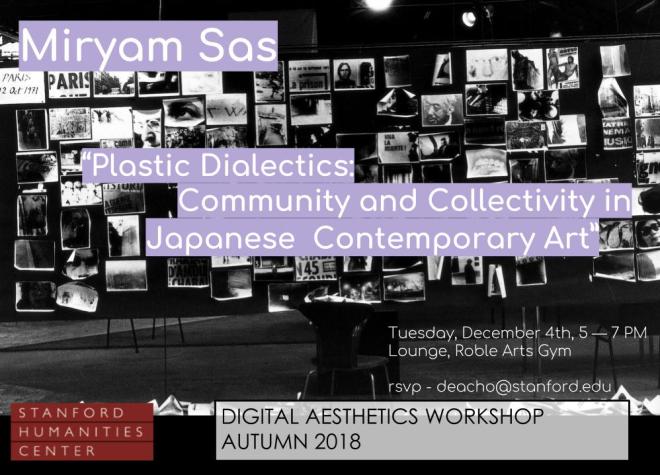
What do we mean when we speak of “collectivity,” collaboration, and community? How have artists and theorists in Japan questioned and created experimental practices that reframe these terms, so crucial to discussions of the arts today? Sas will reflect on issues of collectivity and assemblage as manifested in Japanese contemporary art, drawing examples from 1950s art theory, late 1960s intermedia art, 1970s site-specific photography events, and post 3-11 sculptural installation. Through site-specific critique and new modes of engagement with local space, artists in each of these distinct moments engage in a subtle but powerful rethinking of the frameworks and practices of collectives past and present.
At the next meeting of the Digital Aesthetics Workshop, Miryam Sas, Professor of Comparative Literature and Film & Media at UC Berkeley, will discuss Plastic Dialectics: Community and Collectivity in Japanese Contemporary Art. As we have throughout this quarter, we will meet on Tuesday, Dec 4, from 5-7 at the Roble Gym. RSVP to deacho@stanford.edu – we expect there will be a paper that we will pre-circulate this weekend.
Sas studies Japanese literature, film, theater, and dance; 20th century literature and critical theory; and avant-garde and experimental visual and literary arts. She is the author of Experimental Arts in Postwar Japan: Moments of Encounter, Engagement, and Imagined Return (Harvard, 2010); and Fault Lines: Cultural Memory and Japanese Surrealism(Stanford, 2001). Sas is currently working on a book on media theory and contemporary art in Japan, Feeling Media: Infrastructure, Potentiality, and the Afterlife of Art in Japan, for which she was awarded a President’s Research Fellowship in the Humanities (2017-18). She has published numerous articles in English, French, and Japanese on subjects such as Japanese futurism, cross-cultural performance, intermedia art, butoh dance, pink film and Japanese experimental animation.